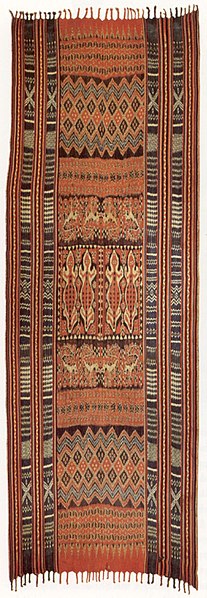Ikat is a dyeing technique from Indonesia used to pattern textiles that employs resist dyeing on the yarns prior to dyeing and weaving the fabric. The term is also used to refer to related and unrelated traditions in other cultures. In Southeast Asia, where it is the most widespread, ikat weaving traditions can be divided into two general clades. The first is found among Daic-speaking peoples. The second, larger group is found among the Austronesian peoples and spread via the Austronesian expansion. Similar dyeing and weaving techniques that developed independently are also present in other regions of the world, including India, Central Asia, Japan, Africa, and the Americas.
A typical Torajan ikat funeral shroud (porilonjong), Sulawesi, Indonesia
The Banton Burial Cloth (c. 1200-1400 AD), the oldest existing example of warp ikat in Southeast Asia at the National Museum of the Philippines). The cloth was found in the sacred Ipot cave of Romblon, Philippines. It is made from abacá, a species of endemic banana.
Detail of a classic Gujarati patola of double ikat from the early 19th century. LACMA textile collections.
A child wearing an ikat robe, Samarkand 19th century. Children often wore small versions of adult clothing.
Resist dyeing (resist-dyeing) is a traditional method of dyeing textiles with patterns. Methods are used to "resist" or prevent the dye from reaching all the cloth, thereby creating a pattern and ground. The most common forms use wax, some type of paste made from starch or mud, or a mechanical resist that manipulates the cloth such as tying or stitching. Another form of resist involves using a dye containing a chemical agent that will repel another type of dye printed over the top. The best-known varieties today include tie-dye, batik, and ikat.
A nembok process in batik-making method especially for batik tulis (handmade batik).
Batik, created using the technique of wax-resist dyeing originated from Indonesia.
Rōketsuzome printing wheels at Roketsuzome Yamamoto, Kyoto.
A mix of modern and traditional Ukrainian pysanky








